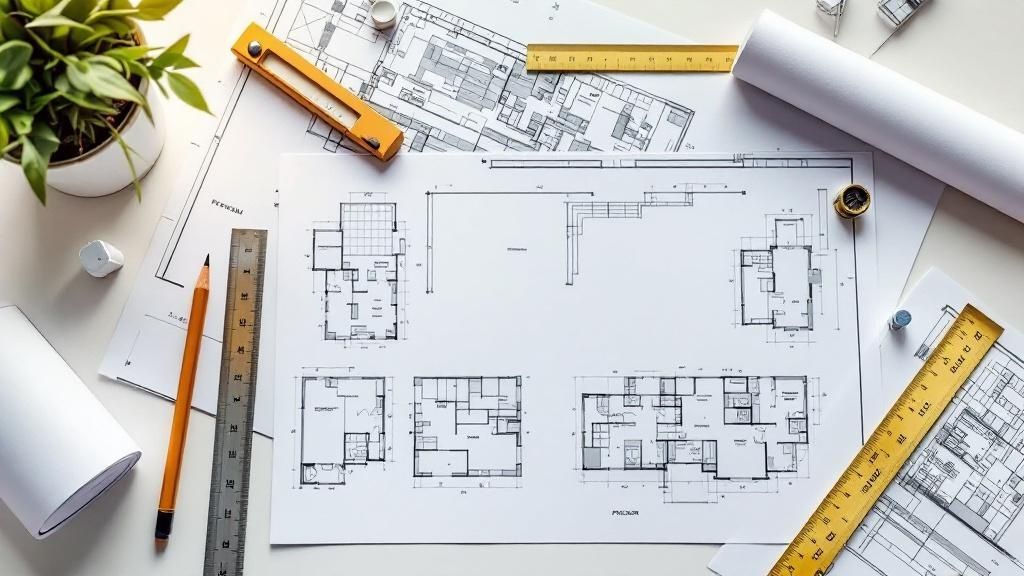Your 2025 Building a Custom Home Checklist: 8 Key Steps for Caulfield

Building a bespoke home in a sought-after suburb like Caulfield is an exciting venture, representing a significant investment in both your lifestyle and financial future. However, the path from a vacant lot to a dream home is complex, filled with critical decisions and potential pitfalls. A well-structured plan is not just advisable; it's essential for ensuring a smooth, cost-effective, and successful project. This comprehensive building a custom home checklist is designed to guide you through every crucial stage of the process, specifically for a Caulfield build.
We will break down the 8 essential milestones, providing actionable insights specifically tailored for projects in the Caulfield area. From securing the right financing and navigating local council regulations to selecting a premier builder and finalising your detailed plans, this guide provides the clarity you need. Following this structured approach will help you move forward with confidence, transforming your architectural vision into a stunning reality. This detailed roundup will equip you to manage your project proactively, avoiding common oversights and ensuring the final result exceeds your expectations without costly delays or budget blowouts. Let's begin laying the foundation for your success.
1. Establish and Secure Financing
The first and most critical step in any custom home journey is securing the necessary financing. Unlike a standard home purchase, financing a custom build involves a specific product known as a construction loan. This type of loan is paid out in stages, or ‘draws’, to your builder as they complete various milestones, from laying the foundation to installing the final fixtures.

This process is integral to the "building a custom home checklist" because without approved funding, your project cannot begin. A common structure is a construction-to-permanent loan, where the initial construction financing automatically converts into a standard home loan once the house is complete and you receive the certificate of occupancy. This streamlines the process, saving you from having to apply for two separate loans.
Key Actions for Securing Your Loan
To navigate this process successfully, start early and be organised. Gaining pre-approval before you even finalise your builder or plans gives you a clear and realistic budget to work with for your Caulfield home.
- Shop Around: Don't just go to your everyday bank. Compare offers from major lenders, mortgage brokers, and local credit unions, as terms for construction loans can vary significantly.
- Prepare Your Documents: Lenders will require detailed plans, a signed contract with your builder, and a comprehensive budget. Having these organised will speed up the application process.
- Understand the Draw Schedule: Familiarise yourself with your lender’s draw schedule and the required inspections at each stage. This ensures your builder receives timely payments, keeping your project on track.
Budgeting for the Unexpected
A crucial aspect of financing is planning for unforeseen issues. It is standard practice to include a contingency fund in your overall budget.
Pro Tip: We strongly advise clients in areas like Caulfield to set aside a contingency fund of at least 10-20% of the total construction cost. This buffer covers unexpected expenses like site issues, material price increases, or design changes, preventing budget blowouts and project delays.
2. Select and Vet Your Builder/Contractor
Choosing the right builder is arguably the most impactful decision you'll make, second only to your budget. This professional relationship will likely last anywhere from six to 18 months, and their expertise directly influences your home's final quality, timeline, and adherence to the budget. A great builder acts as your project manager, quality controller, and trusted partner, turning your architectural plans into a tangible, high-quality home.

This step is a cornerstone of any "building a custom home checklist" because the wrong choice can lead to costly errors, frustrating delays, and immense stress. The selection process should be a thorough investigation into a builder's credentials, experience, financial stability, and communication style. For those building in competitive markets like Caulfield, finding a builder with specific local experience is paramount for navigating council regulations and site-specific challenges.
Key Actions for Vetting Your Builder
A systematic and diligent vetting process will protect your investment and ensure a smoother build. Don't rush this stage; take the time to find a true partner for your project.
- Interview Multiple Candidates: Shortlist at least three builders who specialise in the type of home you want to build in Caulfield. This comparison is vital for understanding different working styles, cost structures, and personalities.
- Verify Credentials: Always check for current builder's licences, comprehensive insurance (including public liability and construction works insurance), and any relevant certifications from professional bodies.
- Visit Active and Completed Projects: Ask to see a recently completed home and one currently under construction. This allows you to assess their workmanship, site organisation, and the quality of their subcontractor teams.
Evaluating Past Performance and Reputation
A builder's track record is the best predictor of your future experience. Look for a history of excellence and satisfied clients.
"Pro Tip: When requesting references, ask for a list of their last five to ten clients, not just a handpicked selection. Contacting recent clients gives you an unfiltered view of their experience with communication, budget management, and how the builder handled any problems that arose during construction."
3. Obtain All Required Permits and Approvals
Navigating the web of council regulations is a non-negotiable step in bringing your custom Caulfield home to life. Securing the proper permits involves a deep dive into local building codes, zoning laws, and specific approval processes that can vary significantly, even between neighbouring suburbs. This stage is a cornerstone of the "building a custom home checklist" as it ensures your project is legal, safe, and compliant, protecting its future value.
This process, which can often take anywhere from two to six months, directly impacts your construction timeline. It involves submitting your detailed architectural plans to the local council for review against regulations covering everything from structural integrity and fire safety to land use and environmental impact. Without these official approvals, construction cannot legally commence, and any work undertaken would be subject to significant fines and demolition orders.
Key Actions for Securing Your Permits
Proactive management of the permit process is essential to avoid lengthy delays. Starting the application process early, ideally during the final stages of the design phase, allows ample time for council review and any necessary revisions.
- Engage Local Expertise: Hire architects or draftspeople who have extensive experience with your local council, such as the City of Glen Eira for projects in Caulfield. Their familiarity with specific requirements can streamline submissions.
- Budget Accordingly: Set aside approximately 1-3% of your total construction cost for permits, council fees, and any associated consultant reports (e.g., soil tests, energy ratings).
- Organise Documentation: Keep meticulous digital and physical copies of all applications, correspondence with the council, and the final approved permits. This documentation is vital for your records and future reference. For a comprehensive guide, you can learn more about how to get a building permit on envyabode.com.au.
Planning for a Smooth Approval Process
A successful permit strategy involves more than just submitting paperwork. It requires careful planning and communication to pre-empt potential roadblocks and keep your project moving forward without unnecessary friction.
Pro Tip: We advise building a positive relationship with your assigned building surveyor or council official. Maintaining open and respectful communication can make it easier to clarify requirements and resolve any issues that arise during the assessment, often preventing minor queries from escalating into major delays.
4. Finalize Detailed Plans and Specifications
With your team assembled, the next critical phase involves transforming your vision into a precise, actionable blueprint. This means finalising the detailed architectural plans and specifications that will guide every step of the construction process. These documents are more than just drawings; they are the legal and technical foundation of your project, dictating everything from structural engineering to the exact brand of tapware.

This step is a non-negotiable part of any building a custom home checklist because it eliminates ambiguity. Comprehensive plans ensure that you, your architect, and your builder all share the same understanding of the project's scope, quality, and final appearance. This meticulous pre-planning is essential for obtaining accurate quotes, securing permits, and preventing costly misunderstandings or changes once construction is underway.
Key Actions for Finalising Your Plans
A collaborative and thorough review process is vital to creating a flawless set of documents. Modern tools can provide unprecedented clarity, helping you visualise the final product before a single sod is turned.
- Embrace 3D Visualisation: Insist on 3D renderings or Building Information Modeling (BIM) for complex areas like kitchens, bathrooms, and living spaces. Tools like Revit or SketchUp allow you to virtually walk through your home, ensuring the layout and flow meet your expectations.
- Detail Every Selection: Create a detailed specifications sheet (often following standards like CSI MasterFormat). This document lists every material, from the type of foundation concrete to the model of your kitchen appliances and the colour of your interior paint.
- Involve Your Builder: While the architect leads the design, your builder should review the plans for constructability. They can provide practical feedback that may simplify construction, reduce costs, or improve the home’s long-term performance.
Planning for Precision and Future Needs
The goal of this stage is to leave nothing to chance. A well-defined plan not only ensures a smoother build but also a home that serves you well into the future.
Pro Tip: When finalising specifications for a project in Caulfield, we recommend including specific "allowances" for items you haven't selected yet, such as light fixtures or tiles. This assigns a budget value within the contract, providing cost control while giving you the flexibility to make the perfect choice later without derailing the budget.
5. Establish Project Timeline and Milestones
With your plans finalised and financing secured, the next essential step is to establish a detailed project timeline. This is more than just a calendar; it's a comprehensive roadmap that sequences every task, from breaking ground to the final handover. A realistic construction timeline with clear milestones enables the proper scheduling of trades, material deliveries, and inspections, providing measurable checkpoints for progress. This detailed schedule is a cornerstone of any successful "building a custom home checklist".
This infographic provides a simplified overview of the major phases in a typical custom home build, illustrating how a 12-month project might be structured.
The visualisation highlights how the bulk of the timeline is dedicated to the core construction phase, which involves multiple overlapping trades and critical path dependencies.
Key Actions for Creating Your Timeline
Creating an effective schedule requires collaboration between you, your builder, and your architect. Modern tools can provide clarity and keep everyone aligned, transforming a complex process into a manageable one.
- Utilise Scheduling Tools: Your builder will likely use professional software like Microsoft Project or specialised apps like CoConstruct to create a detailed Gantt chart. This visualises task dependencies and the project's critical path.
- Align with Payment Draws: Ensure the major construction milestones on your timeline correspond with the payment draw schedule from your lender. This synchronisation prevents delays in funding and keeps the project moving smoothly.
- Factor in External Dependencies: Your timeline must account for council inspections, utility connections, and supplier lead times. Scheduling critical inspections well in advance is crucial to avoid bottlenecks.
Planning for Real-World Conditions
A schedule is a plan, but reality often intervenes. A resilient timeline anticipates potential delays and builds in buffers to absorb them without derailing the entire project.
Pro Tip: For custom builds in areas like Caulfield, where weather can be unpredictable, we recommend adding a 15-20% time buffer to your schedule. This contingency accounts for potential delays from rain, extreme heat, or unforeseen site complications, ensuring your completion date remains realistic.
6. Set Up Insurance and Risk Management
Protecting your significant investment during the construction phase is a non-negotiable part of any custom home project. This involves setting up comprehensive insurance coverage to safeguard against accidents, damage, theft, and liability. A well-structured insurance plan mitigates financial risk for you, your builder, and all contractors involved.
This step is a core component of the "building a custom home checklist" because without it, you are personally exposed to immense financial loss. The primary policy is typically a builder's risk insurance policy (also known as course of construction insurance), which covers the structure and materials. This is often supplemented with public liability insurance to protect against injuries or property damage to third parties.
Key Actions for Comprehensive Coverage
Navigating insurance requires diligence and a proactive approach. Start these conversations early with your builder and a qualified insurance broker to ensure no gaps in coverage exist from the moment your Caulfield site is cleared.
- Clarify Responsibilities: Your building contract should clearly state who is responsible for securing which policy - you or your builder. Typically, the builder arranges builder’s risk and public liability insurance.
- Verify Contractor Insurance: Before any work begins, obtain and verify Certificates of Currency from your builder and all major subcontractors. This ensures they have their own adequate public liability insurance and workers' compensation coverage.
- Plan the Transition: Coordinate with your insurance provider to ensure a seamless transition from the construction policy to a standard homeowner's insurance policy once you receive the certificate of occupancy.
Mitigating Risks Beyond the Policy
A robust risk management strategy goes beyond just the insurance documents. It involves active participation and documentation throughout the build.
Pro Tip: We advise our clients in areas like Caulfield to meticulously document the build's progress with dated photos and videos. This creates an invaluable record for potential insurance claims, providing clear evidence of the materials on-site and the stage of construction if damage, theft, or a dispute occurs.
7. Plan Utility Connections and Infrastructure
An often-overlooked yet critical task in any "building a custom home checklist" is the early coordination of utility connections. This involves more than simply calling the power company; it requires detailed planning for electricity, gas, water, sewer, and high-speed internet services to ensure your new home functions seamlessly from day one. You must engage with utility providers long before breaking ground to understand lead times, connection costs, and any required site preparations.
This process is integral because utilities are the lifeblood of a modern home. Failing to plan can lead to significant delays and expensive last-minute trenching or infrastructure upgrades. For example, some providers in established areas like Caulfield may need months of notice to schedule a new connection, especially if it requires extending main lines or installing new transformers.
Key Actions for Seamless Connections
Proactive management is the key to avoiding utility-related headaches. By thinking ahead, you can integrate these essential services efficiently and even future-proof your home for emerging technologies.
- Contact Providers Early: Reach out to all relevant utility companies (electricity, gas, NBN, water) during the design phase. Provide them with your site plans to get accurate quotes and timelines.
- Plan for Future Capacity: Consider not just your immediate needs, but future ones as well. Will you be adding an electric vehicle charger, a pool, or a sophisticated smart home system later on? Ensure your electrical panel and service can handle the load.
- Coordinate Trenching: Work with your builder to create a unified trenching plan. Digging one trench for multiple utilities (where permissible) is far more efficient and less disruptive to your site than digging several separate ones.
Planning for Modern and Sustainable Living
Integrating modern technology and sustainability from the start can add immense value and long-term savings. This is the ideal time to incorporate advanced systems that are much harder to retrofit later.
Pro Tip: For your new build in Caulfield, we advise clients to plan for infrastructure like EV charging and Solar/Powerwall integration during the initial build. Pre-wiring for high-speed services and strategically placing utility rooms for easy maintenance ensures your home is not only connected but also intelligent and energy-efficient.
8. Establish Quality Control and Inspection Processes
A custom home is a significant investment, and ensuring the final product meets your exacting standards requires a proactive approach to quality control. Implementing systematic inspection protocols guarantees that every stage of construction adheres to architectural specifications, Australian building codes, and your personal expectations for craftsmanship. This goes beyond the mandatory council inspections, involving a layered approach of both official and personal oversight.
This step is a non-negotiable part of the "building a custom home checklist" because it safeguards your investment against defects and future problems. By identifying and rectifying issues as they arise, you prevent minor errors from becoming major, costly repairs down the line. It's about maintaining transparency and accountability throughout the build, from the foundation pour to the final coat of paint.
Key Actions for Ensuring Quality
To effectively manage quality, you must be organised and engaged. This involves setting clear expectations with your builder from the outset and maintaining consistent communication.
- Schedule Regular Site Visits: Walk through the site with your builder at key milestones. This allows you to ask questions and see the progress firsthand, ensuring the work aligns with the plans.
- Document Everything: Use a smartphone app like CompanyCam to take detailed photos of all major systems, such as plumbing and electrical, before they are covered by plasterboard. This creates a permanent visual record of the home's construction.
- Hire Independent Inspectors: For critical stages like the foundation, framing, and pre-handover, consider hiring a third-party inspector. They provide an unbiased expert assessment, catching details that others might miss. Firms specialising in structural or energy efficiency inspections can add immense value.
Creating a System for Accountability
A robust quality control system relies on clear processes and detailed records. This isn't about micromanaging your builder but collaborating to achieve the best possible outcome. For an in-depth guide, explore our construction quality control checklist.
Pro Tip: Create a detailed 'punch list' towards the end of each major construction phase. For projects in areas like Caulfield, we recommend walking through with your builder to list any items needing correction, from a misaligned tile to a paint touch-up. This ensures all fixes are completed before the next phase begins, leading to a smoother final handover.
8-Step Custom Home Checklist Comparison
Item | Implementation Complexity 🔄 | Resource Requirements ⚡ | Expected Outcomes 📊 | Ideal Use Cases 💡 | Key Advantages ⭐ |
Establish and Secure Financing | High - complex pre-approval, draw schedules | Significant - requires detailed plans, 20-30% down payment | Secured funding, financial flexibility during build | Custom home financing with single closing process | Saves time/costs, adjustable loan terms, rate locks |
Select and Vet Your Builder/Contractor | Moderate to High - vetting, interviews, background checks | High - requires time for interviews, site visits | Quality construction, timeline and budget adherence | Ensuring skilled, experienced builder selection | Avoids pitfalls, reduces stress, warranty protection |
Obtain All Required Permits and Approvals | High - navigating codes & approvals, 2-6 month timelines | Moderate - permit fees, administrative effort | Legal compliance, inspection oversight, increased home value | Compliance with local regulations in Caulfield | Protects legal status, ensures inspections, adds value |
Finalize Detailed Plans and Specifications | High - architectural, engineering designs | High - design fees 10-15% of budget | Accurate bids, fewer change orders, legal groundwork | Complex custom designs needing precise specs | Reduces construction costs, prevents misunderstandings |
Establish Project Timeline and Milestones | Moderate - scheduling dependencies, buffers | Moderate - planning tools and ongoing oversight | Timely completion, proactive problem solving | Managing construction schedule and resource flow | Faster completion, clear expectations, early delay detection |
Set Up Insurance and Risk Management | Moderate - choose policies, verify coverage | Moderate - 1-3% additional budget | Financial protection, liability coverage | Protecting investment during construction | Minimizes risk, required by lenders, peace of mind |
Plan Utility Connections and Infrastructure | Moderate - coordination with multiple utilities | Moderate to high - utility fees can be substantial | Proper utility function, integration for smart systems | New construction with complex utility needs | Avoids delays, ensures capacity, qualifies incentives |
Establish Quality Control and Inspection Processes | Moderate - scheduled inspections, documentation | Moderate - inspection fees, time for oversight | Higher build quality, fewer defects and warranty claims | Maintaining standards throughout construction | Early defect detection, code compliance, warranty support |
From Blueprint to Reality: Your Next Steps in Caulfield
Embarking on the journey to create a custom residence in a prestigious suburb like Caulfield is one of the most significant and rewarding undertakings of a lifetime. This comprehensive building a custom home checklist has outlined the critical pillars that transform an architectural vision into a tangible, breathtaking reality. From securing the right financing and meticulously vetting your build partner to finalising detailed plans and navigating the complexities of council permits, each step is a foundational block in your project’s success.
The process is intricate, but it doesn't have to be overwhelming. The true value of this checklist lies not just in ticking off boxes, but in understanding the interconnected nature of each phase. A well-defined budget influences your design possibilities. An experienced builder simplifies the permit process. A detailed project timeline prevents costly delays and manages expectations. Mastering these elements ensures your journey is defined by clarity, control, and confidence.
Key Takeaways for Your Caulfield Project
To synthesise the core principles we've covered, let's highlight the most crucial takeaways:
- Your Team is Your Greatest Asset: The selection of your builder, architect, and designer is the single most important decision you will make. In a discerning market like Caulfield, a team with local expertise, a portfolio of high-end projects, and a transparent communication style is non-negotiable.
- Diligence in Planning Prevents Pain in Construction: The time invested in detailed planning, finalising every specification, and establishing rigorous quality control processes pays immense dividends. Ambiguity is the enemy of both budgets and timelines.
- Proactive Management is Essential: Don’t be a passive observer. Actively engage in the process, from understanding your insurance obligations and planning utility connections well in advance to participating in regular site meetings. Your involvement ensures the final product aligns perfectly with your original vision.
Ultimately, building a custom home is about more than just bricks and mortar; it’s about crafting a backdrop for your life’s most precious moments. It’s an opportunity to create a sanctuary that reflects your personality, supports your lifestyle, and stands as a testament to your achievements. By diligently following this building a custom home checklist, you are not just managing a construction project; you are curating your future. The path from a vacant lot or an old structure to a bespoke Caulfield masterpiece is now clear.
Ready to turn your checklist into a completed project? The team at Envy Abode specialises in delivering architecturally designed luxury homes and extensions in Caulfield and Melbourne's finest suburbs. As an integrated design-build firm, we manage every step of the process detailed in this guide, ensuring a seamless and exceptional result. Contact Envy Abode today to schedule a consultation and take the first concrete step toward realising your dream home.